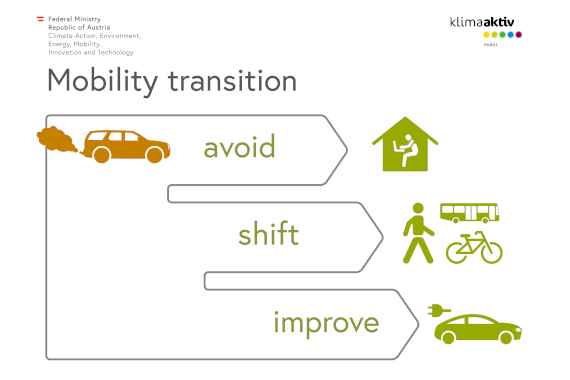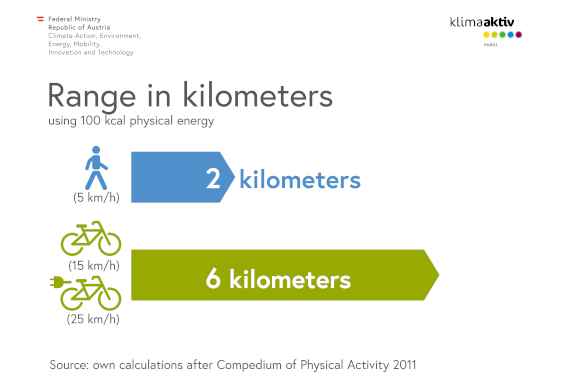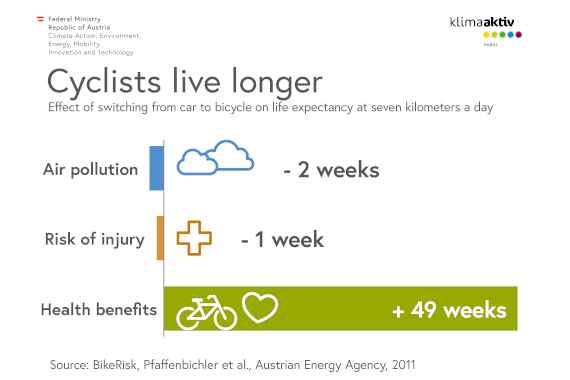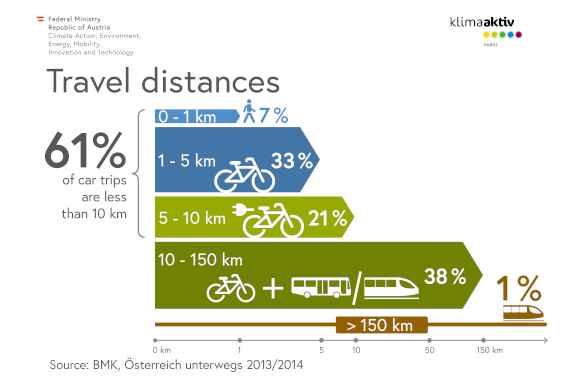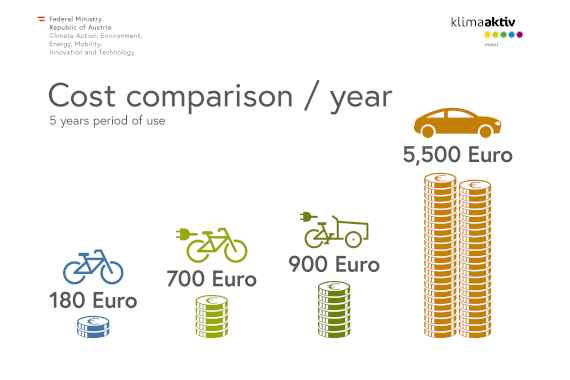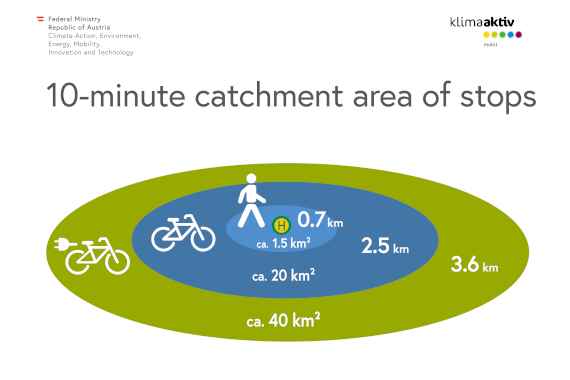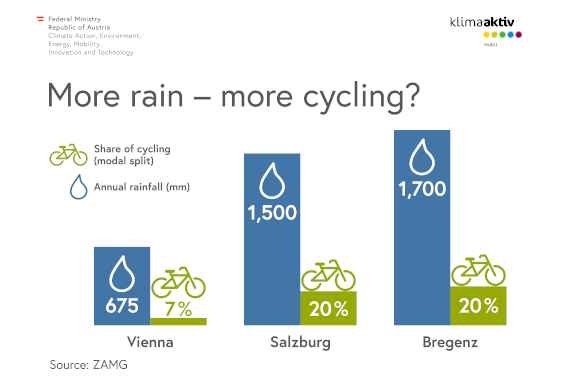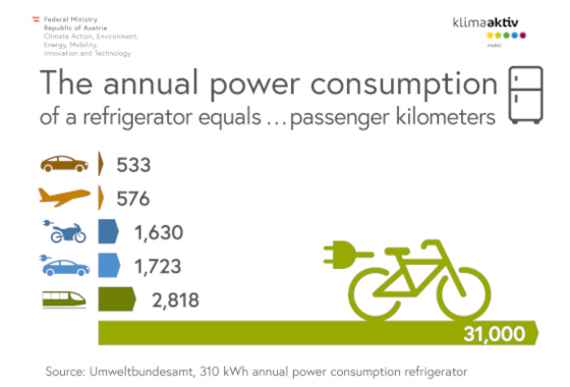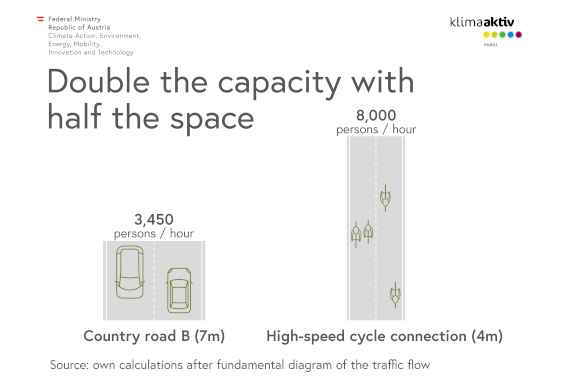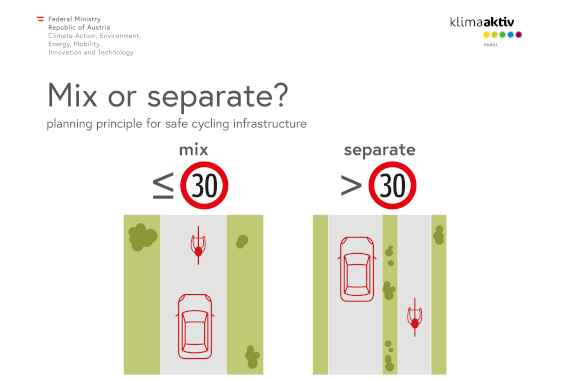Surely, the mobility transition can't work with bicycles?
It can, but not exclusively. More and more people are using the bicycle for their everyday routes – this is an important contribution to reducing CO2-emissions and helps to “rethink” the transport sector in general. Austria is following the principle of “avoid – shift – improve”.
- Avoid traffic that is not absolutely necessary, among other things through smart regional planning. With this in mind, for example the conditions for remote work need to be strengthened and empty runs in freight transport need to be avoided as much as possible.
- Shift mobility to efficient modes of transport, such as cycling, public transport or walking.
- Improve already employed technologies. The goal is to shift energy consumption in transport to alternative fuels and electricity from renewable energy sources in the long run.
Cycling is too exhausting!
Cycling does not need to be strenuous. At moderate speeds it feel more like “walking on two wheels”. But riding a bike one can go three times as far in the same amount of time! The energy expenditure for a speed of 15 km/h is about the same as for a 5 km/h walk. In addition, cycling is relaxing and reduces stress.
As with most things in life, all beginnings are difficult. Therefore, start with short cycling distances and it will quickly become a beloved habit. By the way: The electric tailwind of an e-bike makes cycling even more comfortable!
Cycling is too dangerous!
The truth is: Not all roads are suitable for safe cycling. In general, however, the risk of accidents for cyclists is minimal, as statistics and research repeatedly reveal. Exercise is healthy – that is why regular cycling increases life expectancy by almost a whole year, despite the risk of pollution and accidents! The benefits outweigh the risks by a large margin.
So it should rather say: “Not cycling is dangerous”, because a lack of exercise leads to premature deaths from heart attacks, strokes and diabetes. In Austria, around 400 people are killed in traffic accidents every year. According to estimates however, more than 8,000 people die each year from the consequences of physical inactivity.
Those who cycle every day can maintain a fitness level equivalent to that of a person ten years younger. Therefore, better to ride a bike every day than to go to the gym by car!
I can't get far by bike!
Almost two thirds of all car trips in Austria are shorter than 10 kilometers. That is the ideal distance for cycling! In the city, the bicycle remains unrivalled in speeds on routes calculated from door to door. Shortcuts allow to effortlessly cycle past traffic jams and cycling eliminates the annoying search for a parking space.
Particularly in combination with public transport, the bicycle is a real alternative to the car, even in rural areas. Tip: A folding bike can be carried on public transport without time restrictions, the need for a reservation or additional costs.
E-bikes are way too expensive, I can't afford one!
A car costs around 5,500 euros a year, depending on the price of purchase and the kilometers driven. In comparison, an e-transport bike would cost around 900 euros, e-bikes around 700 euros and a normal bike only 180 euros. When applied to the average working wages, this means that the average person spends around a quarter of their working time (around 430 hours a year) on their own car. To afford an electric bicycle, an average of 55 working hours a year is enough. In the city, the transport bicycle offers a low-cost alternative to the expensive private car, especially for young families.
I prefer using public transport over cycling!
One does not exclude the other: Bicycles and public transport are a dream team. In many cases, the next stop with good connections is not right outside the front door. This additional distance significantly increases the travel times of public transport.
Bike & Ride increases the catchment area of public transport stops. In 10 minutes, about 700 meters are covered on foot. In the same time, cyclists cover about 2.5 kilometers, and e-bikes even about 3.6 kilometers.
Provided public transport stops are equipped with theft-proof and weather-protected bicycle parking facilities and the (e-)bike is used, the catchment area of a station increases from 1.5 km2 (walking) to 20 km2 (bicycle) or even 40 km2 (e-bike). This also applies to the regular route from the stop to the final destination (“last mile”).
This makes Bike & Ride a real alternative to the car, even on longer journeys!
Cycling only makes sense when the weather is nice!
Not every day brings ideal cycling weather – but staying dry while cycling is possible more often than you might think: According to the ZAMG (Zentralanstalt für Meterologie und Geodynamik) precipitation values for Vienna in 2019, 93% of the hours were precipitation-free.
The precipitation values for Salzburg and Bregenz illustrate this particularly well: both cities have a comparatively high share of cycling in the modal split (around 20%) and at the same time relatively high precipitation. Bregenz is the provincial capital with the highest annual precipitation (about 1700mm), Salzburg has about 1500mm. Vienna, with its 675mm annual precipitation only has about a 7% share of cycling.
If you are flexible in terms of time and don’t have to travel too far, you can stay dry while cycling even on rainy days. Just wait fifteen minutes until the rain breaks. And if it still does rain? With the right clothing and equipment, even a little bit of a wet weather can be managed well.
Electric cycling also consumes a lot of energy!
Cycling does not require any fossil energy – only muscle power is used here. Although e-bikes need electricity for their battery, they are very energy-efficient compared to cars and CO2-free when operated with green energy. The annual amount of energy necessary to run a refrigerator is enough for 31,000 kilometers with an e-bike (for comparison: for 533 kilometers with the fossil-fuel-powered car). That is why “cycling with tailwind” is also the most efficient form of electric mobility!
There is no room for additional bike lanes!
In cities, unsealed surfaces are a rare commodity and, in times of global warming, a particularly valuable one. Cycling helps to save space – so more area is available for green space and other uses. This increases the quality of life in cities and helps to save costs.
In fact, individual modes of transport take up very different amounts of inner-city road space: car traffic requires by far the most space, while pedestrian and bicycle traffic are much more space-efficient. At high occupancy rates (80% or more), local public transport is clearly the most space-efficient mode of transport.
In a direct comparison, a country road B (as an example of a priority road) has twice the space consumption at half the capacity compared to a bicycle expressway. Especially in cities, bike lanes save space in the transport system while maintaining the same capacity.
Cyclists should ride on the street!
Especially on roads with a high travel speed and a high traffic volume, cyclists should not ride on the street, because: The faster the cars drive next to cyclists and the higher the speed difference between car and bike, the more serious accidents are.
Therefore, in terms of traffic safety, a structurally separated cycling infrastructure is necessary for safe cycling at speeds above 30 km/h. A bike lane on the roadway is possible at 30 km/h and less.


